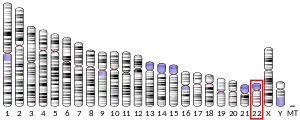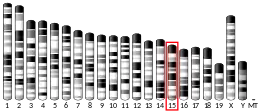Nucleoporin 50 (Nup50) is a protein that in humans is encoded by the NUP50 gene.[5][6]
The nuclear pore complex is a massive structure that extends across the nuclear envelope, forming a gateway that regulates the flow of macromolecules between the nucleus and the cytoplasm. Nucleoporins are the main components of the nuclear pore complex in eukaryotic cells. The protein encoded by this gene is a member of the FG-repeat containing nucleoporins that functions as a soluble cofactor in importin-alpha:beta-mediated nuclear protein import. Pseudogenes of this gene are found on chromosomes 5, 6, and 14. Two transcript variants encoding different isoforms have been found for this gene.[6]
Interactions
NUP50 has been shown to interact with KPNB1[7] and CDKN1B.[8]
A variant of NUP50 a nucleopore basket protein, is associated with sporadic ALS. Its dysfunction precedes the mislocation of TDP-43 from the nucleus to the cytoplasm.[9]
References
- 1 2 3 GRCh38: Ensembl release 89: ENSG00000093000 - Ensembl, May 2017
- 1 2 3 GRCm38: Ensembl release 89: ENSMUSG00000016619 - Ensembl, May 2017
- ↑ "Human PubMed Reference:". National Center for Biotechnology Information, U.S. National Library of Medicine.
- ↑ "Mouse PubMed Reference:". National Center for Biotechnology Information, U.S. National Library of Medicine.
- ↑ Trichet V, Shkolny D, Dunham I, Beare D, McDermid HE (October 1999). "Mapping and complex expression pattern of the human NPAP60L nucleoporin gene". Cytogenet Cell Genet. 85 (3–4): 221–6. doi:10.1159/000015297. PMID 10449902. S2CID 38773521.
- 1 2 "Entrez Gene: NUP50 nucleoporin 50kDa".
- ↑ Lindsay, Mark E; Plafker Kendra; Smith Alicia E; Clurman Bruce E; Macara Ian G (August 2002). "Npap60/Nup50 is a tri-stable switch that stimulates importin-alpha:beta-mediated nuclear protein import". Cell. 110 (3): 349–60. doi:10.1016/S0092-8674(02)00836-X. ISSN 0092-8674. PMID 12176322.
- ↑ Smitherman, M; Lee K; Swanger J; Kapur R; Clurman B E (August 2000). "Characterization and Targeted Disruption of Murine Nup50, a p27Kip1-Interacting Component of the Nuclear Pore Complex". Mol. Cell. Biol. 20 (15): 5631–42. doi:10.1128/MCB.20.15.5631-5642.2000. ISSN 0270-7306. PMC 86029. PMID 10891500.
- ↑ Megat, S; Mora, N; Sanogo, J; et al. (20 January 2023). "Integrative genetic analysis illuminates ALS heritability and identifies risk genes". Nature Communications. 14 (1): 342. Bibcode:2023NatCo..14..342M. doi:10.1038/s41467-022-35724-1. PMC 9860017. PMID 36670122.
Further reading
- Olsen JV, Blagoev B, Gnad F, et al. (2006). "Global, in vivo, and site-specific phosphorylation dynamics in signaling networks". Cell. 127 (3): 635–48. doi:10.1016/j.cell.2006.09.026. PMID 17081983.
- Beausoleil SA, Villén J, Gerber SA, et al. (2006). "A probability-based approach for high-throughput protein phosphorylation analysis and site localization". Nat. Biotechnol. 24 (10): 1285–92. doi:10.1038/nbt1240. PMID 16964243. S2CID 14294292.
- Gerhard DS, Wagner L, Feingold EA, et al. (2004). "The Status, Quality, and Expansion of the NIH Full-Length cDNA Project: The Mammalian Gene Collection (MGC)". Genome Res. 14 (10B): 2121–7. doi:10.1101/gr.2596504. PMC 528928. PMID 15489334.
- Collins JE, Wright CL, Edwards CA, et al. (2005). "A genome annotation-driven approach to cloning the human ORFeome". Genome Biol. 5 (10): R84. doi:10.1186/gb-2004-5-10-r84. PMC 545604. PMID 15461802.
- Ota T, Suzuki Y, Nishikawa T, et al. (2004). "Complete sequencing and characterization of 21,243 full-length human cDNAs". Nat. Genet. 36 (1): 40–5. doi:10.1038/ng1285. PMID 14702039.
- Strausberg RL, Feingold EA, Grouse LH, et al. (2003). "Generation and initial analysis of more than 15,000 full-length human and mouse cDNA sequences". Proc. Natl. Acad. Sci. U.S.A. 99 (26): 16899–903. Bibcode:2002PNAS...9916899M. doi:10.1073/pnas.242603899. PMC 139241. PMID 12477932.
- Swaminathan S, Melchior F (2002). "Nucleocytoplasmic transport: more than the usual suspects". Dev. Cell. 3 (3): 304–6. doi:10.1016/S1534-5807(02)00262-9. PMID 12361592.
- Lindsay ME, Plafker K, Smith AE, et al. (2002). "Npap60/Nup50 is a tri-stable switch that stimulates importin-alpha:beta-mediated nuclear protein import". Cell. 110 (3): 349–60. doi:10.1016/S0092-8674(02)00836-X. PMID 12176322.
- Smitherman M, Lee K, Swanger J, et al. (2000). "Characterization and Targeted Disruption of Murine Nup50, a p27Kip1-Interacting Component of the Nuclear Pore Complex". Mol. Cell. Biol. 20 (15): 5631–42. doi:10.1128/MCB.20.15.5631-5642.2000. PMC 86029. PMID 10891500.
- Guan T, Kehlenbach RH, Schirmer EC, et al. (2000). "Nup50, a Nucleoplasmically Oriented Nucleoporin with a Role in Nuclear Protein Export". Mol. Cell. Biol. 20 (15): 5619–30. doi:10.1128/MCB.20.15.5619-5630.2000. PMC 86026. PMID 10891499.
- Dunham I, Shimizu N, Roe BA, et al. (1999). "The DNA sequence of human chromosome 22". Nature. 402 (6761): 489–95. Bibcode:1999Natur.402..489D. doi:10.1038/990031. PMID 10591208.






